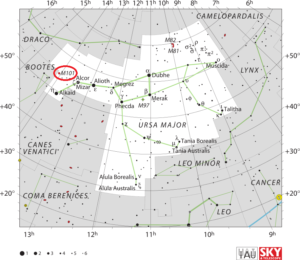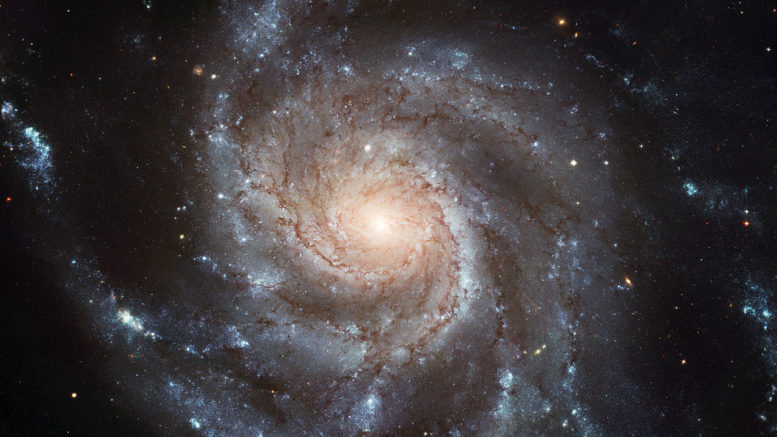Containing over 1 trillion stars, the Messier 101 Pinwheel Galaxy is a spiral galaxy located in the constellation Ursa Major, the Great Bear. The galaxy appears face-on and the galaxy is quite large, but has a low surface brightness and requires exceptionally clear, moonless skies to be seen, even in medium-sized telescopes.
| Description | |
| Visible From Pacific Northwest | April To September |
| Best Time To Observe | April |
| Minimum Size Of Viewing Device | Small Telescope |
| Object Type | Spiral Galaxy |
| Designations | Messier 101, M101, NGC 5457, Pinwheel Galaxy, Arp 26, PGC 50063, UGC 8981, APG 26, K73 610, IRAS 14013+5435, 2MASX J14031258+5420555, MCG+09-23-028, SDSS J140312.52+542056.2, SPB 243, TC 302, VV 344, VV 344a, VV 456, UZC J140312.5+542056, Z 272-21, Z 1401.5+5435 |
| Right Ascension | 14h 03m 12.6s |
| Declination | +54°20’57” |
| Constellation | Ursa Major |
| Absolute magnitude | -21.6 |
| Apparent magnitude | +7.86 |
| Apparent dimensions | 28′.8 x 26′.9 |
| Object Radius | 85,000 light years |
| Distance From Earth | 20,900,000 light years |
History
Messier 101 was discovered by the French astronomer Pierre Méchain on March 27, 1781. Méchain reported the discovery to his colleague Charles Messier, who verified the object’s position and added it to his catalogue with the following note:
Nebula without star, very obscure & pretty large, of 6 or 7 minutes [of arc] in diameter, between the left hand of Boötes & the tail of the great Bear. It is difficult to distinguish when one lits the [grating] wires. (diam. 7′)
Pierre Méchain
William Herschel observed M101 with his 20-foot telescope on September 20, 1783 and later catalogued several of M101’s spiral arm fragments on April 14, 1789, three of which were later assigned their own NGC numbers: H III.787 (NGC 5447), H III.788 (NGC 5461) and H III. William Parsons, 3rd Earl of Rosse observed the object in his 72-inch Newtonian reflector on eight different occasions and sketched it. He was the first to note the spiral structure in M101.
Locating M101 In The Sky
Messier 101 is easy to find because it is located just above the handle of the Big Dipper. It forms a triangle with Alkaid and the double star Mizar/Alcor. It can be found 5.5 degrees northeast of Alkaid and at the same angular separation from Mizar.

Viewing M101
The galaxy is quite large, but has a low surface brightness and requires exceptionally clear, moonless skies to be seen, even in medium-sized telescopes.
The Pinwheel Galaxy can be spotted in 10×50 binoculars under exceptionally good conditions, but only appears as a large, faint patch of light. Small telescopes only reveal the galaxy’s brighter central region, while the spiral structure appears as patchy nebulosity in 4-inch instruments. 8-inch telescopes show the galaxy’s dense core surrounded by a fainter halo dotted with patches of nebulosity and hinting at the spiral structure.
Photographing M101
Messier 101 is a very popular astrophotography target. M101 is bright enough to capture from your backyard, but you’ll need to focus on pulling the surface brightness of the galaxy forward during image processing. From a Bortle Class 8 area, plenty of exposure time (2-3 hours+) is needed to create an image with a healthy SNR (signal-to-noise ratio) per astrobackyard.com. We linked that article below, which is a great reference. It is indeed possible to capture the Pinwheel Galaxy using a DSLR, just make sure to have enough magnification.
Sources And Further Reading
Our reviews of Messier Objects can be found here for those looking for a full list.
https://www.nasa.gov/feature/goddard/2017/messier-101-the-pinwheel-galaxy
https://freestarcharts.com/messier-101
https://www.galactic-hunter.com/post/m101-the-pinwheel-galaxy

Be the first to comment on "Messier 101 Pinwheel Galaxy"